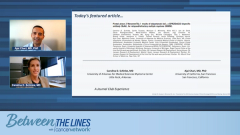
Relapsed/Refractory MM: Safety and Efficacy Data From MonumenTAL-1
Focused discussion on the safety and efficacy data from MonumenTAL-1, which utilized talquetamab monotherapy in patients with relapsed/refractory multiple myeloma.
Episodes in this series

Transcript:
Carolina D. Schinke, MD: Then we look at the efficacy, I think we see some impressive results. So overall, response rates in [MonumenTAL-1 study] cohorts A and B were over 70%; 74% in cohort A, 71% in cohort B. Again, the difference here is just the dosing schedule. Cohort A had weekly dosing, and cohort B had every other week dosing. And then cohort C, the dosing schedule was a little bit of a mix. Some patients had weekly dosing; other patients had every other week. Again, the distinct feature here was prior T-cell–redirecting treatment. And even for those patients who had prior T-cell–directing treatment, in cohort C, the response rate was pretty impressive at 65%.
The 12-month duration of response rate in patients in cohorts A and B were pretty impressive at 80% for cohort A, and 90% in cohort B. We also saw impressive 12-month PFS [progression-free survival] rates; 35% in cohort A, 54% in cohort B, and 38% in cohort C. Again, these are all, I believe, impressive results for this heavily pretreated and refractory patient population. The 12-month overall survivor rate was high across all cohorts, with 77% in cohort A and 77 in cohort B, and a little bit lower at 63% in cohort C. And then just to mention also overall response rate was consistent across all clinically relevant subgroups. Patients with baseline plasmacytomas had a little bit lower response at 39% to 49% compared to those with no baseline plasmacytomas.
In terms of safety, we saw CRS [cytokine release syndrome] was a very common adverse effect. That was seen in 70% across all cohorts. Again, that’s a common event. However, the vast majority was just grade 1 and 2 Very few had a grade 3 or 4, which was in the range of 1% to 2%. Infections is another adverse event that we particularly see with teclistamab or other BCMA-targeting bispecific antibodies, which seem to be a little bit less common. So overall, it was seen in roughly 50% to 60%, and even 70% in cohort C. However, grades 3 and 4 were seen in less than 20% for the first cohorts, cohorts A and B, and then in 27% in cohort C. There are distinct [adverse] effects in patients receiving talquetamab. These are skin, nail, and taste related. So, as we know, GPRC5D is also expressed on cells within the skin, the nails, as well as on the tongue, and that then leads to these very particular and distinct [adverse] effects of nail changes and skin changes. These tend to be rather mild. The vast majority here was grade 1 and 2, but again, also seen very commonly in up to 50%, 60% of patients. Then these taste changes, which we call also dysgeusia, are seen in a lot of patients too, up to 70% throughout all cohorts. Again, interestingly, there is no grade 3 or 4 grading for this particular adverse event. So, all patients only had grades 1 or 2. Again, that is [an adverse] effect that we encounter in this particular bispecific antibody treatment. Adverse events led to dose reductions in a few patients. It was 15% in cohort A and then less than 10% in cohort B or C. We did see that 5 patients also had to discontinue the treatment because of skin- or taste-related changes. Discontinuation due to infections was actually extremely rare, with less than 2% throughout all cohorts.
With that, we conclude that talquetamab demonstrated over 71% in overall response rates across all 3 cohorts—or, sorry, across cohorts A and B, which were the weekly and every other week dosing cohorts. And overall response rate in cohort C with prior T-cell–redirecting treatment was 65%. Rates … were better and were deep and observed in over 55% of patients across all cohorts. Oral, skin, and nail-related adverse events were not treatment-limiting. Grade 3 and 4 infections and neutropenia rates were lower as compared to a BCMA-directed therapies. This modest impact on severe infections that we see with talquetamab suggests a nonoverlapping adverse event profile. We think that we can combine talquetamab with other novel treatments. And there were some interesting data also at ASCO [the American Society of Clinical Oncology annual meeting] regarding combinations with daratumumab and talquetamab. So I believe the future is bright in that regard.
Transcript edited for clarity.
Newsletter
Stay up to date on recent advances in the multidisciplinary approach to cancer.

















































































